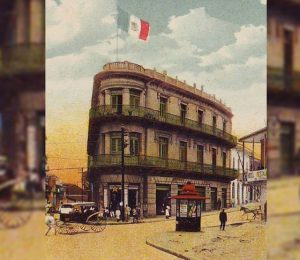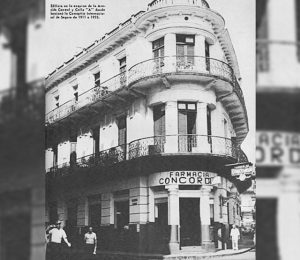Located in a well-attended corner in Avenida Central, between the Santa Ana and San Felipe neighborhoods, La Concordia is an emblematic building that since the beginning of the 19th century, gave life to many businesses and institutions. All while being surrounded by butcher shops and the humble but strident activities of Panama’s new relocated city, including its churches, government buildings and the houses of Panama’s high class elite. From this building one could even appreciate the walled city and its suburbs, including the farms and orchards beyond.
As the Panama Canal construction attracted a new wave of population into the city during the late 1800s, this charming building, property of the Vallarino-Zubieta family at the time, was leased to the American Silvers & Paterson association with the purpose of being transformed into a hotel: La Concordia. It was one of the tallest buildings back then, where a canteen, a cigar factory and a warehouse occupied its ground floor while its roofed kiosk topped the building, offering a spectacular view of the bay, Cerro Ancón and the Cathedral.
During the first half of the 20th century, La Concordia experienced its true Golden Age as it hosted businesses like the Panama Banking Company, a store for the Victor Talking Machine Company and The Isthmus Tobacco Company. For a brief period of time, this historic building served as home to the consulate of the United Mexican States for the Republic of Panama and the Canal Zone, a bar, a school, a pharmacy, and the first international insurance company, co-founded by La Concordia’s owner at the time, Carlos W. Müller.
During World War II, an economic recession sadly forced owners to abandon their properties, leaving behind a landscape of wooden houses with nibbled painting and sullen balconies that deteriorated as the years passed. Here an important transition took place: from luxury and social exclusivity, San Felipe was now considered a place for people with low financial possibilities. After the Invasion in 1989, Panama’s progression into a democratic country initiated a process of identity revaluation.
After being declared a World Heritage Site by UNESCO in 1997, Casco Viejos abandoned surroundings reemerged to inspire local pride. Following this, the Panama Canal Expansion was announced, and the world, once again, had its eyes on Panama. Just like that, history began to repeat itself. Panama’s economy re-flourished and restaurants, bars, hotels, shops and plazas in Casco Viejo began filling with people curious to discover the paradise promised to be found in Panama. Casco Viejo was transformed into a cultural and trendy site for both foreigners and Panamanians. In 2012, the opportunity to re-establish a lodging project in La Concordia was seized in an instant by the Fornós Family. Now, this quintessential building is a romantic boutique hotel that offers the perfect spot to experience Panama’s past and present. A spot where you can both indulge alongside a decades’ worth of memories and marvel at the contemporary surroundings of Panama’s unfolding future. A new chapter is being written in ‘Finca 74’, which starts with the revival of La Concordia. Enrich your stay in the tropics by experiencing this enticing building, where the ruthless fire a century ago wasn’t reason enough to make the magic go away. This time, history not only repeats itself. This time, history outshines itself.









